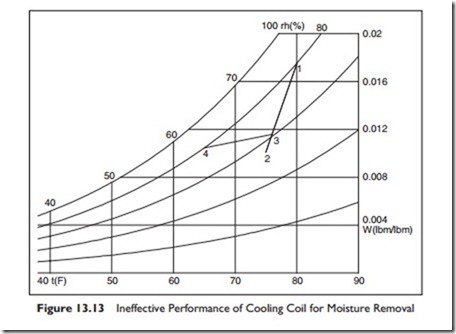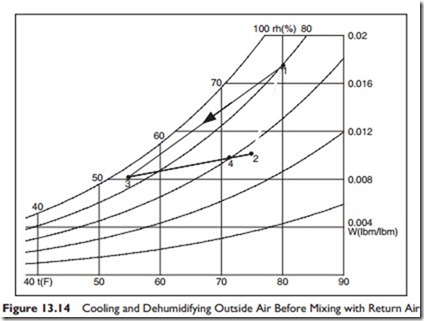Decoupled or Dual Path, and Dedicated Outdoor Air Systems
Our last area of discussion relates to outdoor air. There are situations where mixing the outdoor air with return air and conditioning the mixture is not a good choice.
Let us consider the following example: a humid climate, on a cloudy, very high humidity day that is warm, but not hot.
The typical package air-conditioning system will do a poor job, since the cooling coil will take out very little moisture, because there isn’t adequate sensible load to keep the unit running continuously. The challenge is shown on the psychrometric chart, Figure 13.13.
Point 1 is the outdoor air at 80°F and 80% relative humidity.
Point 2 is the return air from the space at 75°F and 55% relative humidity.
Point 3 shows 20% outside air (Point 1) mixed with 80% return air from the space (Point 2).
Let us assume that the cooling load only requires cooling the air to 65°F.
Point 4 shows this air cooled to the required 65°F. Unfortunately, the condition of the mixed and cooled air at Point 4 contains more moisture than the space.
If this air were introduced into the space, the relative humidity would rise until some equilibrium balance was achieved. To prevent this uncontrolled
increase in moisture, the air going through the coil must be cooled substantially more than is needed for sensible cooling. This is generally not accept- able, as the overcooling would be have to be offset by some form of reheating. Alternative methods of moisture removal are necessary.
This can be achieved in many ways. One way is by treating the outside air before it is introduced into the main air-handling unit. A single cooling coil, designed for the low outdoor air volume and high dehumidification load, may cool and dehumidify this outside air. Typically, this is a deep coil, with a low air-velocity that provides enough time for substantial moisture removal.
In Figure 13.14, we see the diagram illustrating this method:
Point 1 is outside air at the same conditions of 80°F and 80% relative humidity.
Point 2 is the condition of the return air that is mixed with air from the new Point 3.
Point 3 is air that has been cooled and dehumidified to 55°F and 95% relative humidity—a condition that has a much lower moisture content than the space. (Remember, the higher relative humidity at a lower temperature can still mean a lower moisture content.)
Point 4 shows that the mixed air has a lower moisture content than the return air from the space.
If the outside air is 20% of the mixture, it provides about 20% sensible cooling, leaving the main cooling coil to do only as much additional sensible cooling as is necessary.
Another method of achieving the required dehumidification is to provide a bypass around the main cooling coil. A part of the air, let us say 50%, flows through the main cooling coil. This 50% flows at half the velocity through
the main cooling coil, allowing the air to cool down and condense significant moisture. The other 50% of the air bypasses the coil before mixing with the sub-cooled air. The two air streams then mix to produce a mixture with half the sensible cooling and well over half the latent cooling (moisture removal), much better than if no air bypassed the coil. Another variation of this is to bypass only drier room return-air around the cooling coil and have a portion of the return air mix with the outside air, which is then sub-cooled as it passes through the coil.
We have briefly considered using alternative arrangements to deal with high moisture removal. Now we will consider a situation where different requirements make a dual-path system attractive.
Consider a building that includes a large kitchen and an eating area. The building could be designed to have all the necessary kitchen makeup air come in through the main air handler. However, because the kitchen is a more industrial-type environment, rather than an office-type environment, the kitchen makeup air does not need to be conditioned to the same moisture and temperature conditions as the main air supply to the building. In addition, the kitchen may start operation before the rest of the building and shut down well before the rest of the building. This is a case of a mismatch in requirements and a mismatch in timing.
Therefore, it is often better to provide the kitchen makeup air from two sources. First, there is the air from the eating area. In order to avoid distributing food smells around the building, this air from the eating area should not be returned to the main air handler. Instead, it should form the first part of the kitchen exhaust hood makeup air. The transfer can be by a plain opening, an open door, or a duct with a fire damper, depending on local codes and design requirements. The rest of the kitchen exhaust makeup air can be provided from a separate air handler designed to condition the incoming air to provide suit- able kitchen working conditions, often a much less onerous requirement.

